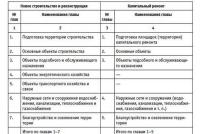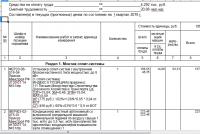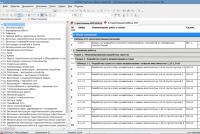Accounting info. Accounting info The reconciliation act is not generated in 1s 8.3
The act of reconciliation of mutual settlements is a special document, which indicates the status of mutual settlements between counterparties for a certain time period. In 1C 8.3, an act of reconciliation can be done in just 1 minute, and this does not require routine collection of information. Consider step by step instructions an example of how to do this.
How to create a new reconciliation act in 1C Accounting
For example, let's form a reconciliation for 14 years between our organization "Servicelog" and our buyer "Konfetprom".
Where in 1C 8.3 can I find the Reconciliation Act? In the interface, the log of reconciliation acts is located on the Purchases and Sales tabs:
To create a new reconciliation, click the "Create" button in the journal. A new document form will open. Let's fill in the main details:

- Organization is ours entity;
- - our buyer or supplier;
- Agreement - if reconciliation is required for a specific agreement (not a mandatory requisite);
- Period - for what dates the reconciliation is performed;
- Reconciliation approved - a flag that prohibits document editing.
Get 267 1C video tutorials for free:
After filling in the main fields, pay attention to the tab "Accounts of calculations", by default it is filled with the necessary values. However, if your organization uses any other accounting accounts, be sure to add them to the list:

The last tab with the settings is "Advanced":

Here you can specify such parameters as:
- Representatives of the organization and the counterparty - persons whose signatures will be indicated on the printed form of the reconciliation report;
- Split by agreement - a flag that allows you to see the breakdown of mutual settlements by agreement;
- Display the full names of documents - if the flag is set, the name in the reconciliation act will look like "Receipt to the current account", if simply "Payment" is not set.
We fill out the act in 1C
We proceed directly to filling in the data on mutual settlements. To do this, the 1C 8 program provides two tabs - "According to organization data" (our credentials) and "According to counterparty data".
To fill in the data of our organization, you can use the button "Fill in according to the data of accounting. accounting ":
Reconciliation of settlements is regularly performed between contractors to identify debts or inaccuracies. For reconciliation in 1C 8.3 Accounting 3.0, a special document is provided, the creation of which will be discussed in this article. Reconciliation reports can be completed for suppliers, buyers and other counterparties.
The document "Statement of reconciliation of calculations" is in the tabs:
Sales "for reconciliation with buyers;
"Purchases" for verification with suppliers.
When you click on the corresponding item, a list of reconciliation acts opens, in which the creation of a new act is performed by the "Create" button. It turns out a document of the form:
Fields to fill in the document:
"Counterparty" - the organization for which you want to make a reconciliation is selected;
"Agreement" - if a reconciliation is required for a specific agreement with the selected counterparty, then the required agreement is selected from the drop-down list. If the reconciliation is carried out for all settlements with this counterparty, then the field is cleared by clicking on "×" at the end of the line;
"Period" - fill in the start and end dates of the period for which you want to perform reconciliation.
Particular attention should be paid to the "Settlement accounts" tab:
The accounts for which settlements are made with the selected counterparty are displayed here. By default, the list already contains G / L accounts, but if you want to expand this list, then use the Add button. If you need to remove an account from the list, then remove the check mark in front of the account name.
In the "According to organization data" tab, when clicking the "Fill in" button, the item "Only according to our organization" is selected:
The 1C 8.3 program will fill in the act automatically with data from the infobase and generate a document ready for printing. Before printing, you need to press the button "Write":
In the menu of the "Print" button, "Reconciliation Act" is selected, the document is displayed as it will look on paper:
Please note that the data was entered only from the part of our organization, the counterparty data was left blank. To enter data from the counterparty into the document, you need to go to the "By counterparty data" tab and click the "Fill" button:
This will fill in the second part of the reconciliation report.
In the "Advanced" tab, you can make the following settings:
fill out the person who will sign the reconciliation act from the organization;
fill out the person who will sign the reconciliation statement from the counterparty;
break down the data for each contract (required if several contracts have been concluded with the counterparty);
display the full name of the documents - the reconciliation report will display the documents on the basis of which settlements were made with the counterparty.
With additional settings, the reconciliation report when printing will look like this:
From the printing form, you can open the document, which is being verified. To do this, you need to click on it in the tabular section of the act. From the menu of the "Print" button, you can display a document with a signature and seal, if this data is entered in the 1C 8.3 database.
The printed reconciliation act is sent to the counterparty for approval, after this procedure, the document is ticked “Reconciliation approved”.
Learn to draw up an act of reconciliation of calculations (1C: Accounting 8.3, revision 3.0)
2016-12-08T13: 37: 38 + 00: 00In this lesson, we will learn how to properly draw up an act of reconciliation of settlements with a counterparty for 1C: Accounting 8.3 (revision 3.0).
Situation.We have long-term cooperation with our counterparty Prodmarket LLC. Prodmarket supplies us with some goods, and we provide it with some services.
Once a quarter, we draw up reconciliation statements on mutual settlements in order to avoid accounting errors, as well as to legally fix the debt to each other, because an act certified by both parties can be used in court.
On October 10, we decided to draw up a reconciliation report for the 3rd quarter. Thus, we were the initiator of drawing up an act of reconciliation of mutual settlements with the counterparty.
According to our data (analysis of accounts 60, 62, 66, 67, 76) at the beginning of the 3rd quarter, we had no debt to each other.
- On September 2, we received goods from the food market in the amount of 4000 rubles.
- On September 3, we paid 4000 rubles from the checkout to the food market.
- On September 24, we rendered services to the food market in the amount of 2500 rubles.
Thus, according to our data at the end of the 3rd quarter the food market owes us 2500 rubles.
We go to the section "Purchases" item "Acts of reconciliation of calculations":

We create new document "The act of reconciliation of settlements with the counterparty". We fill in the counterparty's food market and indicate the period for which the reconciliation act is drawn up (quarter 3):

If it was required to make a reconciliation for a specific agreement, it would be necessary to indicate it in the "Agreement" field. But we carry out a general reconciliation for all contracts, so we leave the contract field empty.
Go to the "Additional" tab and indicate the representatives of our organization and representatives of the food market.
Since we are doing a reconciliation for all contracts, it will be convenient if the lines in printed form are broken down by contracts. To do this, put the checkbox "Break by contracts":

Go to the "Accounting accounts" tab and mark here the accounting accounts that need to be analyzed to reconcile our calculations with the counterparty. Here are the most typical accounts (60, 62, 66 ...), but it is possible to add new ones (the "Add" button):

Finally, go to the "By organization data" tab and click the "Fill in according to accounting data" button:

The tabular part was filled with primary documents and calculation amounts:

We carry out the document and print the reconciliation report:

It can be seen from it that we have zero debt to each other at the beginning of the period, and at the end of the period the food market owes us 2,500 rubles.
Please note that only our data is currently filled in this act. We have yet to find out the data of the counterparty (food market).
We send this version to the counterparty
Let's save this version of the act by clicking on the floppy button above the printable:

The act was saved to the desktop as an Excel file:

We send this file by mail to the counterparty of the food market.
The counterparty makes its own reconciliation
The food market received this file, conducted its own reconciliation and revealed discrepancies in the receipt of September 2. According to his data, the goods were shipped to us not for 4000, as indicated by us, but for 5600 rubles.
We receive an act with discrepancies from the counterparty
Prodmarket indicated this error in the Excel file that we sent it, and then returned this corrected file to us by mail.
We correct our accounting error
Having learned about these discrepancies, we raised the primary documents and found out that the operator missed one position when filling in the invoice. We fixed this error, re-entered the created act and again pressed the button "Fill in according to accounting data":

Since we are sure that this act will already be final, go to the "By counterparty data" tab and click the "Fill in by organization data" button:

The tabular section from the first tab is completely copied into this one, only the amounts in Debit and Credit are inverted (swapped):

We send a new (final) act to the counterparty
We print the reconciliation report again. In duplicate. We sign both, put a seal and send them to the food market (by mail or by courier) in order to get back one certified copy:

After receiving a reverse copy of the act from the food market, go back to the document and check the "Reconciliation approved" checkbox. This will protect the document from accidental changes in the future:

In this lesson, we learned how to draw up an act of reconciliation with a counterparty in 1C: Accounting 8.3, revision 3.0.
The software product of domestic development "1C: Accounts department 8" works at many Russian enterprises. Users choose it for its user-friendly interface and thoughtful automation of all accounting areas, including the organization's settlements with suppliers and buyers. For a quick check of debt and mutual settlements between counterparties, the document "Reconciliation Act" is used. 1C makes it possible to generate it automatically. Let's consider how to make a reconciliation act in 1C using the example of the latest version of the program - "1C: Enterprise 8.3".
How to create?
For the formation of the reconciliation report in the section "Purchases and sales" there is a separate hyperlink - "Acts of reconciliation of settlements", located in the subsection "Settlements with counterparties".
We press and in the journal we see all the documents created before. To make a new reconciliation, click the "Create" button located on the panel just above the journal, and fill in the details at the top of the document, which are required to be filled in are underlined with a red line:

- "Counterparty". Is it an organization or individual entrepreneurwith which we check;
- "Agreement". We fill in the requisite only if necessary. If the field is left blank, the printed form will include movements for all contracts with the counterparty;
- "Period". We determine the time period of interest to us;
- The fields "Organization" and "Currency" are filled in automatically depending on the settings of the directories.
If you select the check box "Reconciliation approved", you will not be able to edit the document. We bet only after agreeing on the result with the supplier or buyer.
In addition to the "header" for the correct formation of the reconciliation act, you need to fill in some data in the form tabs.
- "Settlement accounting accounts". Here the accounts are automatically pulled up, on which settlements with counterparties are most often taken into account: 60, 62, 66, 67, 76. If necessary, you can make an adjustment to the list;

- "Additionally". Here you need to enter the names of representatives of both organizations in the appropriate fields and, if necessary, check the box "Split by agreement".

In principle, these tabs can be left alone. 1C can generate a printed form without breaking down according to contracts and only according to the indicated accounts, with blank lines where the names of representatives should be. We'll have to spend a little time writing them in with a ballpoint pen.
How to fill with data?
In the tab "According to organization data" we press the button "Fill", then - "Fill in according to accounting data".

The system will automatically fill in the table with lines indicating the primary documents and amounts. We carry out (the corresponding button is above the requisites) and print (the button with the printer is in the same place).


The printed form contains data on mutual settlements, amounts, turnovers and the final balance. It is divided into two halves:
- According to our organization;
- According to the counterparty. This part must be completed by the supplier or purchaser.
You can make a printed form of the reconciliation act by clicking on the appropriate button, or you can save it to a file (button with a floppy disk). Available formats - Microsoft Word and Excel, text document, web page and others.

We sign and send to the one we check with.
You can send an Excel file to the counterparty to fill it with his own data. Then, in case of discrepancies, we will not need to print and sign the reconciliation statement again.
If the accounting data of the counterparty and our organization coincide, and the reconciliation act was signed without discrepancies, in the upper part of the form we put the checkbox "Reconciliation approved", save and calm down.
If the reconciliation act contains discrepancies, then first of all you need to find an error in the accounting of our organization or counterparty (incorrect amount, document, date, etc.) and make corrections. After that, reopen the document in 1C, go to the "According to the counterparty" tab, fill in the appropriate button, print the final act and send it to the counterparty. After receiving the signed document, save the form in 1C from accidental editing using the checkbox "Reconciliation approved".

The act of reconciliation of mutual settlements is called a special document in which mutual settlements for a certain period of time are indicated between counterparties. In a software product called "1C 8.3", the verification act can be carried out literally in one minute. And, what is very important, this work does not require routine collection of information. And now, giving an example, let's see how this can be done.
In the program "1C Accounting 3.0" we make a new reconciliation act
For example, we will carry out a reconciliation for 2014 between our buyer "Confetprom" and the enterprise "Servicelog".
In the interface, the log of reconciliation acts is located on the tabs called "Sales" and "Purchases":
In order to form a new reconciliation in the journal, you need to press the button called "Create". After that, the form of a new required document will open. Next, we fill in the main details:
The firm is our legal entity;
Counterparty - our client (buyer);
Agreement - if necessary, reconciliation by specific agreement (requisite is not required);
Period - for which dates the reconciliation is carried out;
Reconciliation agreed - flag, makes it impossible to change the document.
After filling in the main fields, look at the tab named "Settlement accounts", which by default is filled with the necessary values.
However, if the company uses some other accounting accounts, you must definitely add them to the list:
The last tab with settings called "Advanced" looks like this:
The following parameters are specified here:
Representatives of the counterparty and the company - persons whose signatures will be indicated on the printed form of the reconciliation report;
Split according to the concluded agreements (contracts) - the flag, in the printed form "1C" makes it possible to see the breakdown of mutual settlements in the context of contracts;
Display the full names of each of the documents - if the checkbox is checked, then the name in the reconciliation act will look like "Receipt to current account". If this is not established, then simply "Payment".
How to fill out an act in 1C?
Now let's move on to filling out the information on mutual settlements. For this purpose, the software product has two tabs - "According to the counterparty" and "According to the organization" (our accounting information).
To fill in the information of our company, it is possible to use the button with the name "Fill in according to accounting data":
According to the agreement with the counterparty, it is possible to fill in the tab called "According to the counterparty" from our information using a similar button.
After filling in the necessary data, using the "Write" button, you need to write the document. Now this document can be printed:
After reconciliation of the reconciliation act in your counterparty, you need to correctly check the box with the name "Reconciliation approved". After installing it, it will be impossible to correct the document.






